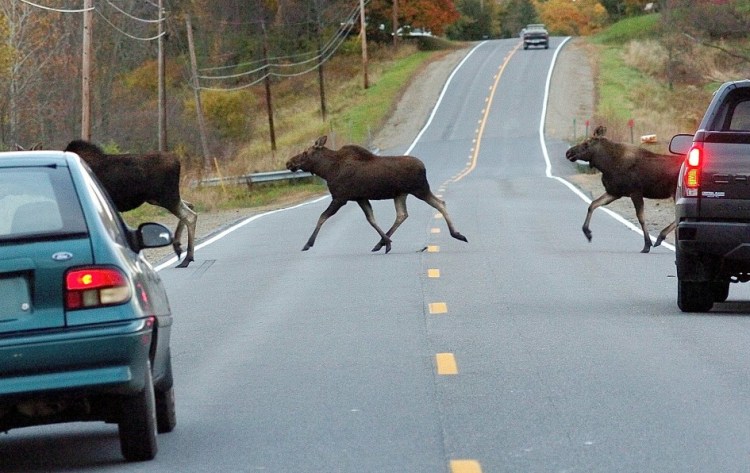It might be just roadkill to most passers-by, but to the state’s wildlife biologists, those animal carcasses on the side of the highway are teeming with something useful: scientific data.
In the past five years, Maine Audubon has used a network of citizen scientists to track sightings of animals – alive and dead – on or along the state’s roads. The volunteers record everything from frogs and snakes to deer and moose.
The study is one of only two statewide research projects in the U.S. focused on wildlife along roadways. It is modeled after a project run by a research center in California.
Using the data, researchers have been able to map out places along major state roads that have high concentrations of animal road crossings. Audubon hopes that the data will be used by state and local governments to install wildlife crossings, such as fencing and expanded under-road culverts that can give animals safe passage and prevent collisions with vehicles.
It’s more than an effort to reduce roadkills. For some endangered species, safe road crossings might be the difference between survival and extinction.
“If we want to maintain the diversity of wildlife we have into the future, this is one of the key issues we need to address, or we may risk losing species,” said Barbara Charry, a conservation biologist with Falmouth-based Maine Audubon.
Wildlife-vehicle collisions are the No. 1 cause of wildlife mortality in the United States, and the biggest threat to a wide range of animals that need to dodge traffic to reach food, water or breeding territory.
“Roads are the most extensive form of impact humans have on natural systems,” said Fraser Shilling, co-director at the Road Ecology Center at the University of California, Davis.
“For most species, roads are going to be the primary cause of mortality,” he added.
AN EMERGING FIELD OF STUDY
Examining the impact that roads and highways have on the natural world is an emerging field of study that pairs ecology and transportation planning. The field of research is still in its infancy, but is attracting interest globally. It involves wildlife crossings and roadkill risks, but also the effects that pollution, erosion and invasive species have on roadside ecosystems.
Transportation planners examine specific areas for wildlife crossings, such as moose habitat in Maine, to post warning signs and take other localized steps to minimize collisions. However, long-term studies over large geographic areas, such as Maine Audubon’s project, can give much richer and holistic data, Shilling said. Volunteer-driven research also gets around the perennial difficulty of financing scientific projects.
“We don’t have to wait around for funding; we can deploy people to start collecting data so we can get answers,” Shilling said.
In the course of the Maine wildlife crossing study, 460 volunteers recorded the sightings of more than 6,000 individual animals and identified 153 different species. Roughly 60 percent of the observations were dead animals, and the most common species included wild turkey, porcupine, gray squirrel, raccoon, skunk and white-tailed deer.
Volunteers log their observations in an online database. An interactive map shows areas where various animals frequently try to cross a road or highway.
The maps shows high-density animal crossings on the east bank of the Kennebec River in Dresden, on a stretch of Interstate 295 between the Bucknam Road exit and Falmouth spur in Falmouth, and on Route 1 between Brunswick and Bath, among many other areas. A hot spot on I-295 through Falmouth, for example, lists roadkill such as chipmunks, porcupines, painted turtles, raccoons, red foxes, skunks and deer.
Usually, the busiest locations are centered on wetlands, ponds and rivers. Crossings are most common when a road comes near or bisects a wetland.
That makes a lot of sense, because animals congregate around water, Charry said. About 85 percent of Maine’s vertebrate species live in or use those habitats at least part of the year.
When roads bisect or come near water resources, it makes it harder and more dangerous for animals to get to where they need to go.
REDUCING COLLISIONS, MORTALITY
Road engineers probably aren’t going to start designing bridges and rerouting roads for common animals such as raccoons and turkeys, but the data can be valuable to reduce areas where collisions are most likely.
“This is about finding where the concentrations are, where you get the biggest bang for your buck,” Charry said.
Some threatened species need special attention. Charry calls the threat to Blanding’s and spotted turtles the most compelling examples of the impact that road mortality has had on a species.
Blanding’s turtles are endangered and spotted turtles threatened, and one of the biggest threats to the survival of both species in the state is motor vehicles. The remaining turtle populations are concentrated in southern York County, one of the most densely populated and well-traveled parts of the state. The turtles can live 60 to 80 years and take more than a decade to reach reproductive age, so the loss of each adult turtle can have a significant impact on the population.
The turtles also tend to cross roads between April and June in order to reach habitat where they feed and lay their eggs. According to the Maine Department of Inland Fisheries and Wildlife, Blanding’s turtles readily travel more than a mile overland between wetlands and use up to six different wetlands per season.
The species are so sensitive that losing even a few turtles a year to car collisions can lead to their extinction in Maine, according to DIF&W. To help, the state has for years put up seasonal turtle crossing signs in the spring to warn motorists about the animals.
Other species, such as the black racer snake and New England cottontail rabbit, are also threatened by road mortality, Charry said. In the last three years, Audubon enlisted volunteers to examine roadsides in York County because of the threat to the species.
With road crossing data in hand, the Maine Department of Transportation hopes to put it to use designing wildlife crossings on road construction projects, and Audubon hopes municipal governments will include the findings in their own road construction.
When the Transportation Department had limited data, the wildlife crossings it installed tended to focus on safety features to deal with collisions involving moose, deer and other large animals. For example, warning signs equipped with flashing lights to alert motorists of moose are a common sight on roads in remote areas of northern and western Maine.
“It is definitely a road safety issue,” said Richard Bostwick, a wildlife biologist with the MDOT.
Incorporating some of the Audubon data will give the department a better blueprint for areas to highlight when considering future road reconstruction.
CREATING WILDLIFE CROSSINGS
For the Transportation Department, the issue is also about protecting motorists. Moose crashes, especially, can lead to injury or death of motorists. Between 2010 and 2014, there were six fatal crashes involving moose, and 23 crashes that resulted in an incapacitating injury, according to the MDOT.
But collisions with smaller animals can be dangerous, too. The department reported 621 crashes involving animals other than deer, moose, bear and turkey between 2010 and 2014. Thirteen of those crashes resulted in an incapacitating injury and 25 in a non-incapacitating injury, according to the department. The economic loss of those crashes is estimated at $7.4 million.
The state has built comprehensive wildlife crossings in Gorham, Caribou and Dixfield, where fencing and natural bottom culverts have been installed to coax animals underneath the roadway.
The Gorham project used oversized bridges with 8-foot fences to guide animals into two brooks and under the roadway, said Bostwick. Game cameras at the site have picked up deer, raccoon and turkeys using the passage, Bostwick said. Cameras at the Caribou site have picked up bear, lynx and fisher, he added.
“The hard part is convincing the animals to use it,” he said. “Most of the crossing structures work way better if you have fencing leading up to it, and when fencing is next to other people’s property, it is not that easy to incorporate.”
In some cases, wildlife are already using structures such as culverts to get from one side of a road to the other, and the crossing can be improved simply with the addition of fencing, Shilling said.
“It doesn’t have to be a big build project,” he said. “Usually cheaper makes it easier to do.”
Other U.S. states and foreign countries have already installed large-scale wildlife passages to cross major highways. In Florida, state and federal agencies added fencing and an underpass to help Florida panther cross a busy state highway, a year after 25 of the critically endangered animals were killed by vehicles. Washington state last year started construction of a huge wildlife overpass above Interstate 90, to allow animals such as elk and bear to cross the major highway, which bisects the Cascade Mountains. Canada and European countries have invested in similar crossings.
Beyond transportation planning, roadside studies are valuable simply for the information they provide about animals that wouldn’t be collected otherwise. For example, the California road watch project is the No. 1 wildlife observation system in the state, Shilling said.
“It’s something really useful to observation of animals in a particular place and time,” he said. “We don’t think of it as finding out where animals are dying; it is also finding out where animals are living.”
Send questions/comments to the editors.






Comments are no longer available on this story